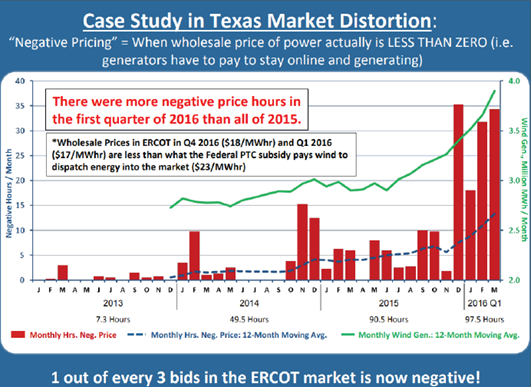Wind Subsidies and ‘Predatory Pricing’ in Texas (Part II: Harming ERCOT)
By Bill Peacock -- October 14, 2020“Artificially low electricity prices offered by renewable generators in Texas have led to bankruptcy for non-renewable generators, including Panda Temple Power, Energy Future Holdings, and Exelon Generation Texas Power.”
While sellers offer special promotions, negative prices in electricity markets make no sense except in the context of renewable energy subsidies. ERCOT explains the anomaly:
Market prices tend to go negative when there is low consumer demand and the thermal generators that have chosen to remain online cannot be backed down further to allow the available, lower-cost wind generation to serve consumer demand. In situations like this, some wind generators will be curtailed to balance generation with load. In these cases, since wind is the marginal generation, it sets the market price, which may be low or negative. In 2017, system-wide negative pricing occurred during 64 hours; in 2018, as of August, during 30 hours.
Figure 1: Negative Electricity Prices in Texas

Source: Texas Public Policy Foundation
When evaluating the effect of renewable subsidies in Texas, William Hogan, PhD., Professor of Global Energy Policy, Harvard University, notes that
wind capacity in Texas thus has an incentive to operate as much as possible, even at locational prices less than zero. … Subsidized wind energy is not only increasing the frequency of negative prices in Electric Reliability Council of Texas (ERCOT), it is decreasing prices in every hour that the wind farms are generating.
In 2017, Donna Nelson as chair of the Public Utility Commission of Texas similarly noted the problems caused by the wind Production Tax Credit. “You can see if your average summer price is $24/MWh and you’re paying one of the segments of the market $23/MWh, that’s going to distort the market and drive prices down.” (She should add that taxpayers in and outside of Texas are subsidizing–paying for–the ‘lower’ prices in Texas.)
The pricing practices of renewable generators that pushing the market price down in ERCOT have repeatedly been blamed for harming thermal generators by lower their profitability and decreasing investment in new thermal generation. This in turn has led to lower reserve margins and decreased grid reliability. Nelson observed the problem is particularly harmful at times of high demand:
Last summer, for the first time, we saw high-demand days where about 4,000 MW of wind was online. That’s not enough where you can count on wind to always be there, but it is enough to distort prices at the peak.
Traditional generators, including NextEra Energy, Calpine, NRG, and Exelon, have fingered the low prices as cause for a looming crisis:
Electricity is essential to our everyday lives, and our growing economy. Did you know Texas is on course for a power reliability crisis, with the potential for regular rolling blackouts in just a few short years? With low temperatures earlier this week, we narrowly escaped rolling blackouts. We won’t be so lucky in the years ahead if we don’t take action now.
Artificially low electricity prices offered by renewable generators in Texas have led to bankruptcy for generators Panda Temple Power, Energy Future Holdings, and Exelon Generation Texas Power. No matter what price a renewable generator sells its electricity for, it receives a better return than its competitors because of subsidies.
With almost half their income and benefits coming from local, state, and federal governments, renewable generators are far less concerned about the price at which they sell than their competitors.
Texas utility regulators, fearing capacity shortfalls, have for some time been very interested in increasing prices–but not very interested in pursuing antitrust investigations into industry pricing practices. Part 3 tomorrow will examine this issue.
——————
Bill Peacock is Policy Director at The Energy Alliance, a project of the Texas Business Coalition. This post is a revised version of a study prepared for the Alliance. Part I yesterday began this series.